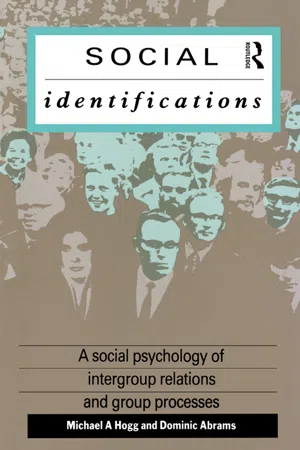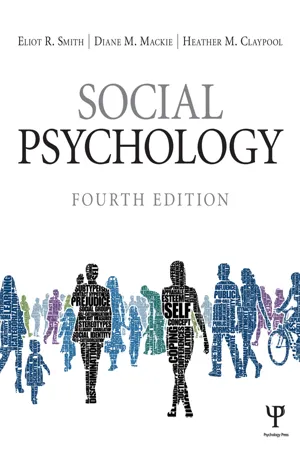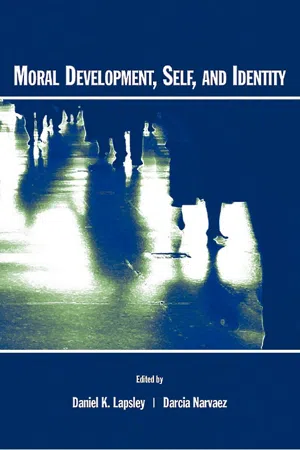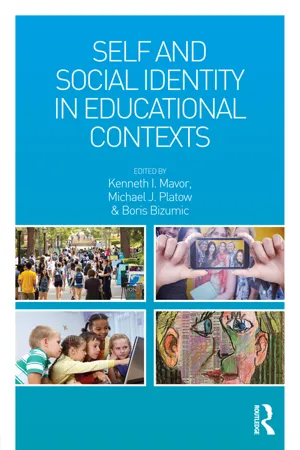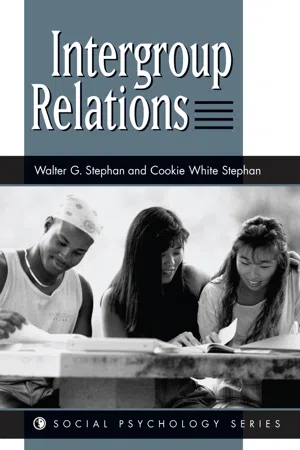Social Sciences
Social Identity in the US
Social identity in the US refers to the way individuals define themselves in relation to their social groups, such as race, ethnicity, gender, religion, or socioeconomic status. It encompasses the shared beliefs, values, and behaviors that shape group membership and influence how individuals perceive themselves and others. Social identity plays a significant role in shaping social interactions, attitudes, and behaviors within American society.
Written by Perlego with AI-assistance
Related key terms
11 Key excerpts on "Social Identity in the US"
- eBook - ePub
Social Identifications
A Social Psychology of Intergroup Relations and Group Processes
- Dominic Abrams, Michael A. Hogg(Authors)
- 2006(Publication Date)
- Routledge(Publisher)
social identity as a means of resolving this issue.Introduction
Social identity is defined as ‘the individual’s knowledge that he belongs to certain social groups together with some emotional and value significance to him of the group membership’ (Tajfel 1972a: 31), where a social group is ‘two or more individuals who share a common social identification of themselves or, which is nearly the same thing, perceive themselves to be members of the same social category’ (Turner 1982:15). These quotations convey some fundamental aspects of the social identity approach. Identity, specifically social identity, and group belongingness are inextricably linked in the sense that one’s conception or definition of who one is (one’s identity) is largely composed of self-descriptions in terms of the defining characteristics of social groups to which one belongs. This belongingness is psychological , it is not merely knowledge of a group’s attributes. Identification with a social group is a psychological state very different from merely being designated as falling into one social category or another. It is phenomenologically real and has important self-evaluative consequences.In this chapter we present the social identity approach, its assumptions, its theoretical propositions, and its scope. This is intended to be a theory chapter to equip the reader for subsequent chapters which explore specific topics that the approach addresses. In turn, these later chapters will provide the empirical findings which have bearing on the theory and will dwell in more detail and elaborate upon those aspects of theory relevant to the topic. However, before doing this we shall spend some time contextualizing the approach. We feel it is very important to show where the social identity perspective fits in social psychology: how it differs from other perspectives, what assumptions it shares. Here we are really concerned with metatheory, with what type - eBook - ePub
Contemporary Social Psychological Theories
Second Edition
- Peter J. Burke(Author)
- 2018(Publication Date)
- Stanford University Press(Publisher)
5 SOCIAL IDENTITY THEORY Michael A. Hogg INTRODUCTIONSocial identity theory is a social psychological analysis of the role of self-conception in group membership, group processes, and intergroup relations. It embraces a number of interrelated concepts and subtheories that focus on social-cognitive, motivational, social-interactive, and macrosocial facets of group life. The theory, which can be considered a midrange theory, is explicitly framed by a conviction that collective phenomena cannot be adequately explained in terms of isolated individual processes or interpersonal interaction alone and that social psychology should place larger-scale social phenomena near the top of its scientific agenda.Social identity theory defines group cognitively—in terms of people’s self-conception as group members. A group exists psychologically if three or more people construe and evaluate themselves in terms of shared attributes that distinguish them collectively from other people. Social identity theory addresses phenomena such as prejudice, discrimination, ethnocentrism, stereotyping, intergroup conflict, conformity, normative behavior, group polarization, crowd behavior, organizational behavior, leadership, deviance, and group cohesiveness.Social identity theory was first developed at the start of the 1970s in Britain by Henri Tajfel, out of his scientific and personal interests in social perception, social categorization, and social comparison and prejudice, discrimination, and intergroup conflict. Over the past forty-five years social identity theory has attracted many collaborators and followers. It has developed and matured conceptually and has motivated, and continues to motivate, a prodigious quantity of research. Although initially a European analysis of intergroup relations, since the early 1990s it has become fully accepted around the world as one of mainstream social psychology’s most significant general theories of the relationship between self and group. However, this popularity has sometimes brought with it a disjunction between some readings of social identity concepts and the concepts themselves. - eBook - ePub
An Introduction to Social Psychology
Global Perspectives
- James Alcock, Stan Sadava(Authors)
- 2014(Publication Date)
- SAGE Publications Ltd(Publisher)
These theories have jointly had a powerful impact on modern social psychology, particularly with regard to our understanding of large-scale social phenomena such as prejudice, stereotyping, ethnocentrism and intergroup conflict. While we have seen how Social Identity Theory focuses on how group and category memberships shape our social identities, we shall now explore how its derivative, Self-Categorization Theory, describes how individuals become unified into a psychological group (Turner, 1985; Turner & Oakes, 1986). Turner (1985), partly in response to the growing interest in social cognition within American social psychology, focused attention on the importance of the categorization of oneself and others as being at the root of both social identity and the group and intergroup phenomena associated with it. According to Self-Categorization Theory, group behaviour would not be possible without the cognitive process of social identity (Turner, 1982; Hogg, 2006). A shared social identity leads to a shared social vision and social norms and provides the basis for cooperation and leadership. Because we identify ourselves as members of groups, we are influenced by the shared belief system of the group to the extent that it shapes our thoughts and values and behaviours. For example, if you are a volunteer member of an environmental group, your membership will further sensitize you to a number of serious environmental issues and will also provide a path of action to deal with them. Thus, we have many social identities, and the situation determines which is salient at a given moment - eBook - ePub
- Joel Harvey, Derval Ambrose, Joel Harvey, Derval Ambrose(Authors)
- 2022(Publication Date)
- Routledge(Publisher)
3 Social Identity Theories Deborah Morris and Elanor WebbDOI: 10.4324/9781315560243-3Introduction
Group membership arises from an evolutionary need to belong, self-protect, survive, and thrive (Over, 2016 ). From our group membership, it is argued that individual self-concept, identity, beliefs, motivations, and behaviour can be understood. The relationship between ‘I’ and ‘we’, and how group membership impacts on self-identity and behaviour, is of long-standing interest to social psychologists (Hogg, 2018 ). Group membership and its relationship to self-concept and offending behaviour is also a core concern for those working with forensic populations.Group membership is broadly defined as a “set of individuals who hold a common social identification or view themselves as members of the same social category”1 (Stets & Burke, 2000 , p. 225). The criterion for social category is broad. It can range from temporary membership based on transient criteria and time-limited activities, through to more enduring, stable, or demographic membership variables. Group membership can also constitute the perception of a collective shared social identity (SI), which, in turn, can facilitate group behaviour (Hogg & Rinella, 2019 ). Social psychological experiments have consistently demonstrated that group membership has far-reaching consequences for self-concept, and for relationships and behaviour between and within groups across settings, including healthcare (Bochatay et al., 2019 ). While different theories have been developed to account for group behaviour and its relationship with self-concept, SI approaches remain the dominant ‘meta-theory’ (Hogg & Vaughn, 2018 ).Social Identity Theories
From their inception, SI theories have been concerned with attempting to account for the extreme behaviours of individuals enacted in the context of group membership. As such, they are well positioned to account for behaviours that fall outside of social norms, including offending in the context of mental disorder. They are rooted in post-World War II political dogma that attempted to understand Nazism and the psychosocial processes that made acts, such as genocide possible. In this context, initial models that focused on individual factors, such as the Authoritarian Personality (Adorno et al., 1950 ), were developed. They promoted the belief that behaviour in the Nazi regime was the manifestation of individual [personality] dysfunction- a belief that was consistent with post-war formulations that emphasised the ‘Germans are different’ hypothesis. Sherif’s (1966) - eBook - ePub
Social Psychology
Fourth Edition
- Eliot R. Smith, Diane M. Mackie, Heather M. Claypool(Authors)
- 2014(Publication Date)
- Psychology Press(Publisher)
The chapter concludes with a discussion of the effects of belonging to a group that others look down on. From playgrounds to boardrooms, being Muslim, speaking with an accent, using a wheelchair, being gay or lesbian, or being on welfare can provoke scorn, dislike, and avoidance. Such negative group identities can take their toll on individuals and groups. But this outcome is not inevitable, and the chapter concludes by describing how people resist the implications of a negative identity and even work to change society’s evaluation of their groups.CATEGORIZING ONESELF AS A GROUP MEMBER
Some group memberships are so important that they become a basic part of our view of ourselves. Try asking a friend to take a piece of paper and write 10 different sentences beginning “I am …” When people perform this task they typically list some individual characteristics such as “I am outgoing” or “I am tall,” but they also list group memberships: “I am a woman,” “I am German.” In fact, most people list more group than individual characteristics (M. H. Kuhn & McPartland, 1954). The process of seeing oneself as a member of a group is known asself-categorization(J. C. Turner, Hogg, Oakes, Reicher, & Wetherell, 1987). Self-categorization is flexible and can readily shift (Mussweiler, Gabriel, & Bodenhausen, 2000). Depending on the social context, for example, sometimes you may see yourself as a Mexican-American, other times as a student, and still other times as a unique individual, with group memberships temporarily receding into the background. The termsocial identityrefers to the way we feel about the group memberships that we share with others (M. Rosenberg, 1979; Tajfel, 1972). Social identity turns “I” into “we”; it extends the self out beyond the skin to include other members of our groups—and, as we will see, it generally involves positive feelings about both ourselves, and those others.self-categorizationthe process of seeing oneself as a member of a social groupsocial identitythose aspects of the self-concept that derive from an individual’s knowledge and feelings about the group memberships he or she shares with othersAlthough some group memberships are only fleetingly important—being part of the “white shirts” team in a lunch-hour basketball game, for example—most group memberships are stable and enduring. Membership in gender and ethnic groups lasts a lifetime. Being a member of the Kardashian or the Hilton family, or being Muslim, Roman Catholic, or Buddhist can be just as long-lasting. How do we learn what characteristics are associated with our groups? - eBook - ePub
- Tom R. Tyler, Roderick M. Kramer, Oliver P. John(Authors)
- 2014(Publication Date)
- Psychology Press(Publisher)
Part II The Nature of the Social SelfPassage contains an image
Chapter 4 Connecting the Person to the Social: The Functions of Social Identification
Kay Deaux Anne Reid Kim Mizrahi Dave Cotting City University of New YorkDOI: 10.4324/9781315805689-4After decades of emphasizing the individual, U.S. social psychologists have rediscovered the social self. Nudged by their European colleagues, who have typically placed more emphasis on group-level phenomena (Doise, 1986 ), significant numbers of U.S. investigators have turned their attention to questions that address the links between self and others. Social psychologists are theoretically committed to exploring the links between individuals and their social worlds. Yet, with our skill in creating specific social settings for experimental participants, we sometimes fail to pay attention to the larger social system in which people actually engage, choose, respond, and despair. A comprehensive analysis of the social self needs to attend to these issues and to develop theoretical models that explicitly incorporate the social as well as the individual.Social identification, we argue here, is a key conceptual link between the individual and society. When a person defines him- or herself in terms of a category or group of somehow similar people, the person takes on shared meanings of that categorical label’s implication, as well as assuming elements of a common agenda for action. These collectively defined meanings and actions are part of the social climate, the social representations constructed and conveyed to members of a society (Moscovici, 1988 ). At the same time, individuals bring to their claims of category membership a set of unique experiences and possibly idiosyncratic reasons for claiming that identity. At this juncture between the individual and the societal, social identification can play a critical role.The analysis of social identity owes a debt to the theorizing of Henri Tajfel (1978) . In developing social identity theory, Tajfel and his colleagues, most notably John Turner, proposed a coherent account of how people define themselves, not solely in terms of individual characteristics but also as part of a group of people with whom some traits, emotions, and actions are shared. As a theory of intergroup behavior, in particular, social identity theory has led the way for more than a generation of social psychologists. Although we acknowledge our debt to social identity theory, our analysis is not strictly tied to that theoretical framework. Indeed, part of our concern with the motivations that lead to social identification is prompted by a realization that social identity theory has not adequately explored the varying functions1 that identification might serve (also see Deaux, 1996 ). Other models of social identity, including those of sociologists such as Stryker (1980) and McCall and Simmons (1978) - eBook - ePub
- Daniel K. Lapsley, Darcia Narv ez, Daniel K. Lapsley, Darcia Narv ez(Authors)
- 2004(Publication Date)
- Psychology Press(Publisher)
identity as a category of human experience. As the quote illustrates, there is a consensus among those who write on the subject that group identity is usually forged in a social and political context that includes— but is considerably broader than—classical anthropological notions of culture as a worldview or shared way of life. However, identity is also a matter of profound importance for the psychological development and well-being of individual agents. Identity theorists sometimes emphasize the social–cultural side of identity and sometimes the personal–psychological side, but they seldom distinguish between the two. And when they do, the distinction is often flawed, as we show by discussing certain developments in social psychology.To set the stage for that discussion, we note that the seemingly obvious distinction between personal and group identity is much more complex than it first appears, as is the subdivision of the latter into social identity and cultural identity. Part of the complexity is the fact that each of these terms has a subjective sense as well as an objective one. For instance, anyone who looks at your passport can see, as an objective fact, that you have a certain citizenship and hence a certain official group identity. Because you are personally aware of this fact about yourself, it is reasonable to assume in the absence of contrary evidence that you are complicit in it (i.e., that you are prepared to identify yourself as a citizen of the nation mentioned on your passport). This self-identification is rooted in what some call a subjective fact—that is, your disposition to endorse, affirm, or (to use R. M. Hare’s, 1951, well-known phrase) “prescribe for yourself” (p. 155-158) a specific affiliation with a certain group. Although it may seem like a chicken-and-egg sort of question to ask which of these two facts ultimately depends on the other, we share Augusto Blasi’s (1991) view that the subjective one is conceptually primary. What makes specifically human groups interestingly different from biological organisms or simple aggregations, such as a pile of rocks, is the cognitive state of their members and, by extension, the recognition of that cognitive state by outsiders. In other words, a human group (qua human, of course; we do not mean psychosocially irrelevant categories such as “featherless bipeds”) is constituted by the affiliative dispositions, thoughts, intentions, commitments, and so on, of its members and by the supervenient realization on the part of other persons that the group in question is so constituted. Following the model proposed by Frederick Barth (discussed below), we further suggest that the paradigm case of this sort of constitution is what he called the “boundary definition” of an ethnic group, whereby some people set themselves off from their neighbors for strategic reasons and, consequently, come to think of themselves as having a special way of life, a shared history, and other such commonalities—all of which add up to their group identity. - eBook - ePub
The New Psychology of Health
Unlocking the Social Cure
- Catherine Haslam, Jolanda Jetten, Tegan Cruwys, Genevieve Dingle, S. Alexander Haslam(Authors)
- 2018(Publication Date)
- Routledge(Publisher)
Chapter 1 . In particular, this is because they challenge the dominant model of the self that prevails in psychology (and in Western society as a whole) which sees the true nature of the person as residing in their immutable individuality, and hence which sees pathways to health as largely requiring engagement with, and mobilisation of, this individuality and an associated sense of personal identity.The alternative view that we have set out does not question the importance of individuality or personal identity for our sense of personhood or for our behaviour. However, it suggests that this is most likely to have an impact on health and well-being where it emerges out of, rather than independently of, meaningful group memberships (Greenaway et al., 2015; Jetten et al., 2015). Indeed, more generally, we suggest that people’s internalised group memberships – that is, their social identities – can be an essential source of psychological robustness and resilience. In large part this is because, as we have seen, social identities constitute key psychological resources of the form summarised in Figure 2.8 . Moreover, as well as being psychological, these resources have important material consequences for the groups they are members of and for the social world that those groups are part of.This can be seen clearly in each of the three examples with which we started this chapter. In Sardinia, the residents of the mountain villages are observed to have a fierce and proud sense of their shared and distinctive identity (Pinker, 2015); at the Magh Mela pilgrims revel in the opportunity to live out their shared religious faith (Tewari et al., 2012); in outback Australia resilient farmers report feeling a strong sense of belonging with others in their community that helps them to cope with the adversity of drought and hardship (McLaren & Challis, 2009; McPhedran & De Leo, 2013b; Schirmer, Mylek, Peel, & Yabsley, 2015). In all these cases it is not simply personal resilience or hardiness that protects health; rather this seems to flow from depersonalised connections between people that are a source of support, solidarity, and strength. - eBook - ePub
- Kenneth I. Mavor, Michael J. Platow, Boris Bizumic, Kenneth I. Mavor, Michael J. Platow, Boris Bizumic(Authors)
- 2017(Publication Date)
- Routledge(Publisher)
One of the fundamental principles of social identity theorising is that group membership will only have an impact upon individuals’ behaviour to the extent that it is internalised into their sense of self as part of their social identity – so that ‘we’ becomes part of ‘me’. Indeed, Tajfel’s definition of social identity as ‘the individual’s knowledge that he [or she] belongs to certain social groups together with some emotional and value significance to him [or her] of this group membership’ (1972, p. 292) makes it clear that a group membership needs to be psychologically significant for a person in order for it to have psychological (and behavioural) impact on them.This point was confirmed in some of the original laboratory studies out of which social identity theory developed. These minimal group studies involved schoolboys being asked to assign points (signifying small sums of money) to members of two different groups – one to which they apparently belonged and one to which they did not (Tajfel, Flament, Billig and Bundy, 1971). The groups had no prior meaning (being based on things such as liking for abstract paintings that the boys did not know), and yet the boys used them as a basis for their behaviour – generally giving more points to boys who were in their own group (the ingroup) than they did to those who were in the other group (the outgroup). Importantly, though, subsequent studies demonstrated that this pattern of ingroup favouritism was only shown by participants who identified with the minimal groups to which they had been assigned. Those who did not were ‘left cold’ by the minimal group procedure and it had little impact on their behaviour (Gagnon and Bourhis, 1996; see Spears and Otten, 2012).This same point also holds in the world of groups outside the laboratory, where social identification proves to be a more or less universal moderator of group-based social behaviour. For example, while people tend generally to like and trust ingroups more than outgroups, to feel more connected to their members, and to communicate and work better with them, these effects are more marked for high identifiers than for low identifiers (for reviews, see Haslam, 2001; Ellemers, Spears and Doosje, 1999). - eBook - ePub
- Cookie W Stephan(Author)
- 2018(Publication Date)
- Routledge(Publisher)
A second consequence is the assumption that, within each group, people are alike. The ingroup thinks that its members share certain usually positive characteristics and that members of the outgroup share other often negative characteristics. For example, Somalians who backed clan leader Mohamed Farrah Aidid perceived themselves as an ingroup with shared positive characteristics and perceived the backers of previous dictator Mohamed Siad Barre as an outgroup with shared negative characteristics. These two common consequences of social categorization mark the beginning of the process by which mere categorization is transformed into negative stereotyping.This chapter discusses two related theories, social identity and self-categorization, that explore the causes and consequences of categorization into groups. The major assumptions of social identity theory are first discussed, and then recent models concerning the perception of outgroup homogeneity deriving from social identity theory are examined. Next, a related theory, self-categorization theory, is described. Finally, two proposals to mitigate the negative aspects of the categorization of individuals into ingroups and outgroups, both of which use concepts derived from social identity and self-categorization theories, are described.Social Identity Theory
Henri Tajfel and his colleagues (Tajfel, 1978, 1982; Tajfel & Turner, 1979, 1986) believe that the self is composed of multiple identities. For Tajfel, personal identity consists of those aspects of the self that are based on individual characteristics, such as personality traits; social identity consists of those aspects of the self that are based on group memberships (Turner, Hogg, Oakes, Reicher, & Wetherell, 1987 ). Personal and social identity are inversely related; when one’s focus is on oneself as a unique individual, the focus is not on oneself as a member of a group or groups, and vice versa.Any interpersonal interaction can be placed on a continuum ranging from purely interpersonal, dependent solely on individuals’ personal relationships and characteristics (personal identity), to purely intergroup, dependent completely on individuals’ membership in social groups (social identity). At the social identity extreme, an interaction leads one to think of himself or herself as a member of an ingroup and to conceive of others as members of some outgroup. The nearer the interaction to the intergroup extreme of the continuum, the more social identity is evoked. - eBook - ePub
- Richard Jenkins(Author)
- 2014(Publication Date)
- Routledge(Publisher)
4 UNDERSTANDING IDENTIFICATIONOne of the assumptions that much social science shares with the ‘everyday thinking’ of ‘common sense’ or ‘common knowledge’ is a radical distinction between the individual and the collective.1 This means that collective identity and individual identity are typically understood as different kinds of phenomena, and the relationships between unique individuality and shared collectivity tend to be unexamined or treated as axiomatic. Much otherwise sophisticated sociological argument, for example, offers a ‘black box’ where there should be an attempt to understand identification processes. Social psychology does look at process, of course, but whether it be symbolic interactionist ‘identity theory’ (Burke and Stets 2009), ‘social identity theory’ (Brewer and Hewstone 2004; Capozza and Brown 2000; Ellemers and Haslam 2012; Hogg and Abrams 1988; Robinson 1996), or ‘discourse theory’ (Antaki and Widdicombe 1998; Potter 1996; Potter and Wetherell 1987), the focus is typically on individuals: ‘personal’ identification and ‘social’ identification are treated as different psychological conditions or constructs, and groups are understood in a coarse-grained and reified fashion. Something important is still taken for granted, something important still missed (although for a psychological contribution that begins to problematise this absence, see Ashton et al. 2004).In this book I adopt another approach. This perspective, which is not dramatically new, argues that:
Index pages curate the most relevant extracts from our library of academic textbooks. They’ve been created using an in-house natural language model (NLM), each adding context and meaning to key research topics.
